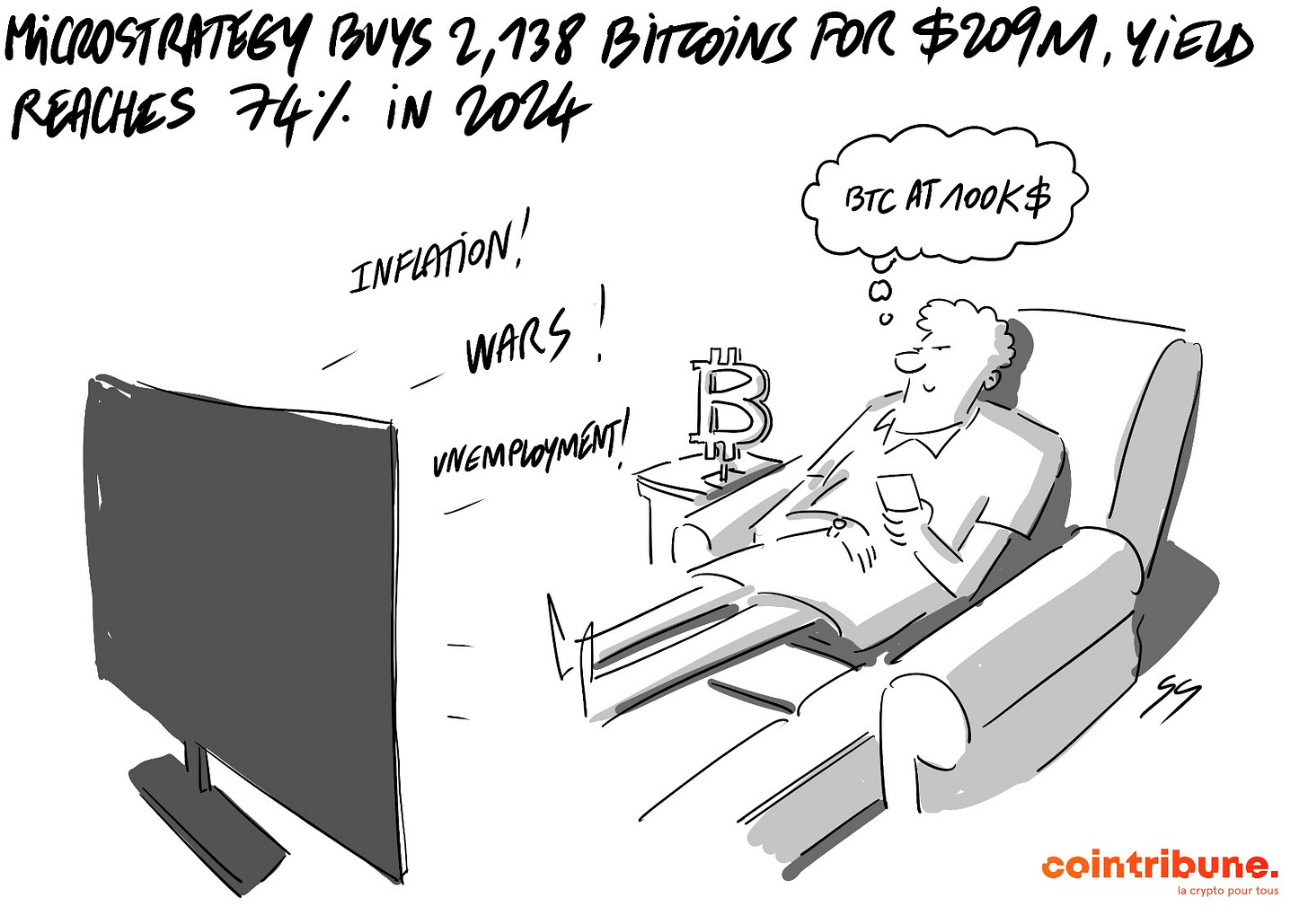🛒 MicroStrategy strengthens its arsenal with 2,138 BTC !
Welcome to the Daily Tribune of Tuesday, December 31, 2024 ☕️
Hello Cointribe! 🚀
Today is Tuesday, December 31, 2024, and like every day from Tuesday to Saturday, we summarize the news from the last 24 hours that you shouldn’t miss !
But first…
✍️ Cartoon of the day:
A quick look at the market…
🌡️ Temperature:
Partially sunny 🌤️
24h crypto recap! ⏱
🚀 TAO, FET, and Render: The blockchain & AI revolution
Cryptos based on artificial intelligence, TAO, FET, and Render, currently dominate social influence rankings, according to data from LunarCrush. TAO stands out with 7,250 publications and generated 1.5 million interactions, achieving a social dominance of 0.70%, thanks to an effective communication strategy. FET and Render follow with 5,220 publications and 816,000 interactions each, reaching a dominance of 0.50%. FET distinguishes itself with its autonomous agents in automation, while Render offers decentralized graphic rendering solutions suitable for the digital design and virtual reality sectors.
These projects symbolize the growing alliance between blockchain and AI, with revolutionary application prospects. However, their success will depend on addressing challenges such as scalability and regulatory adoption.
📉 Less pressure: Is Ethereum preparing for a rebound ?
Ethereum (ETH) is experiencing a notable decrease in selling pressure, suggesting a possible market rebound. Several factors explain this trend: a positive funding rate at 0.01, a sign of traders’ confidence in a price rise; a buyer/seller ratio of 0.57, showing dominance of demand; a 3.18% increase in open interest in 24 hours, indicating the entry of new investors into the market; and significant liquidations of short positions amounting to 6 million dollars, further reducing selling pressure.
In addition, the decrease in supply on exchange platforms shows that investors are accumulating their ETH in anticipation of higher prices, while net flows from large holders remain positive, reflecting their ongoing confidence.
💸 Tether attracts banks toward stablecoins
With record profits projected at over 10 billion dollars for 2024, Tether, the issuer of USDT, is redefining stablecoin standards and pushing banking giants to enter this market. In Europe, initiatives like that of Société Générale (stablecoin backed by the euro) and Deutsche Bank are multiplying, while in Asia, Standard Chartered is exploring a stablecoin linked to the Hong Kong dollar.
In the United States, JPMorgan positions itself with its JPM Coin but remains cautious in the face of regulatory uncertainties. This stablecoin boom, catalyzed by Tether, nonetheless raises concerns about financial stability and reserve regulations, while marking a new era for the global financial system.
🛒 MicroStrategy strengthens its reserves with 2,138 additional BTC
MicroStrategy continues its bold strategy by acquiring 2,138 bitcoins for a total of 209 million dollars between December 23 and December 29, 2024, bringing its total reserves to 446,400 BTC, which is valued at 41.5 billion dollars. Funded by the sale of nearly 592,987 shares, this acquisition reinforces the company's leading position in institutional adoption of Bitcoin.
Michael Saylor, co-founder of MicroStrategy, reaffirmed his commitment to a long-term vision for Bitcoin, despite market fluctuations. At the same time, the company is seeking to expand its financing capabilities through a request to the SEC to increase the number of authorized shares. This ambitious strategy, although encouraging for institutional adoption of cryptos, raises questions about the risks of stock dilution and long-term financial sustainability.
The crypto of the day: Fasttoken (FTN)
Fasttoken (FTN) is the native crypto of Bahamut, a public Layer 1 blockchain based on Ethereum, using an innovative consensus mechanism PoSA (Proof of Stake and Activity). This revolutionary technology encourages active use of smart contracts to determine block producers and provides increased transparency and a new way for businesses to monetize their user bases.
FTN was originally designed as an ERC-20 token for the SoftConstruct and Fastex ecosystems before migrating to Bahamut. It is used for payments in gaming applications and as a basis for blockchain services on Bahamut. Holders benefit from reduced fees on the network, staking mechanisms, and direct participation in the ecosystem's governance.
Recent performances
Current Price: €3.53
24-hour change: +5.1 %
Market capitalisation: €1.51 billion
Rank on CoinMarketCap: #87
Bitcoin in 2025: The 3 Signals to watch for an explosion or a collapse
In 2024, Bitcoin reached a historic peak of $108,000, driven by the "Trump Bump" effect, before falling into a range between $92,500 and $99,000. This stagnation is attributed to a decline in institutional volumes and reduced activity related to the holiday season. Nevertheless, companies like MicroStrategy continue to bet on Bitcoin, recently accumulating an additional 5,200 BTC. This bold institutional strategy reflects a long-term vision and fuels speculation about a potential rebound in 2025, while Donald Trump's inauguration could serve as a catalyst.
Three major signals emerge as critical factors for the evolution of Bitcoin's price in 2025. The first is related to liquidity: expected refunds from FTX, estimated at $16 billion, as early as January 2025, could inject fresh funds into the market and stimulate transaction volumes. Moreover, Bitcoin's dominance in the crypto market remains high (56.49%), an indicator of its resilience despite a global market capitalization slowdown to $3.27 trillion. Meanwhile, the Fear & Greed Index is frozen at 50, reflecting cautious neutrality among investors in the face of uncertainties.
However, signals of concern persist. Cyberattacks are becoming more sophisticated, increasingly targeting investors through advanced phishing techniques and malware. Additionally, analysts remain divided on the potential impact of Trump's presidency: some, optimistic, see an opportunity for Bitcoin to exceed new peaks, while others, such as Arthur Hayes, predict a massive collapse due to economic and political uncertainties.









